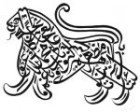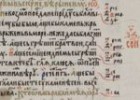From the depth of ages
Slavonic Writing and Culture Day

Slavonic Writing and Culture Day is celebrated every year on the 24th of May on Kiril and Mephodiy Remembrance Day, the fathers of Slavonic writing. For several years this holiday has been uniting Slavonic peoples reminding them of the indissoluble historical bonds.
Hebrew calligraphy

Hebrew alphabet (alefbet) consists of 27 consonants .The russian word «алфавит» as its analogues in many other languages emanates from the first two letters of hebrew - “alef” and “bet”, along with it one can be pleased with the fact that 5 letters of russian alphabet emanate from hebrew - Ж, Ц, Ч, Ш и Щ.
History of European calligraphy

The cuneiform script is the earliest known form of written expression. Created by the Sumerians from ca. 3000 BC (with predecessors reaching into the late 4th millennium Uruk IV period), cuneiform writing began as a system of pictographs. Over time, the pictorial representations became simplified and more abstract.
The history of Russian writing

The history of Slavic and consequently Russian writing forming differs fundamentally from the one of the Latin language. Virtually very little is known about the time and language forming conditions and thus scientists sayings are controversial. Many questions haven’t been answered even now.
Arabic writing

The first arabic writing is conventionally said to emerge in the first centuary of hidjra – the 7- th a.d. By that time the arbic alphabet had virtually formed but not completely. The archaic writing was rather primitive and had been used in Arabia since islamic state forming there at the time of Muhhamed anf first califs. One can already notice traits peculiar to classical arabic writing in that protoarabian writing - the same letter could correlate with three or four foneme that later differenciated between each other with additional symbols – over and under lower-case marks in orm of diacritical points. Later symbols of "shadda or tashtit" were brought into using to signify consonants. Wovelization came into being more later. The form of letters was taken from fomer Semitic handwritings. Orthography emerged later – the necessity of text wovelization ripened only by the end of the 7-th centuary. The early arabic writing virtually imitated the syrian one.Unfortunately it`s dififficult to date emerging of arabic alphabet exactly, but all evidences tell us about the foreislamic period of it`s origin.
Mongolian Calligraphy in Contemporary Art

At the present time Mongolian calligraphy a very important form of indigenous art is still relatively rare. More recently however this artwork has become a bit more prevalent as a small number of artists have become increasingly involved in the creation of this work. A comprehensive description of the nature and significance of this art has however yet to be made available to both the Mongolian people at home and interested people abroad as well.
Origins of Calligraphic Illumination of the Holy Bible in Belarus

The first East Slavic copy of the Bible, “Gennadievsky”, was written in Novgorod Veliky in 1499 and was very modestly decorated. The book was written in semi-uncial font and decorated with one headband and small cinnabar initials. The corpus of richly ornamented Bibles created in Belarus from 1502-1507 is the finest sample of a Cyrillic book art. The book calligraphic design is gorgeous, and the only miniature in the book represents the subject of Sophia’s (God’s Wisdom) personification. The manuscript of Matvei Ivanovich (Matvei Desyatov), called “Desyatoglav”, is now kept at the Academy of Science at Vassilievsky Island in St Petersburg.



